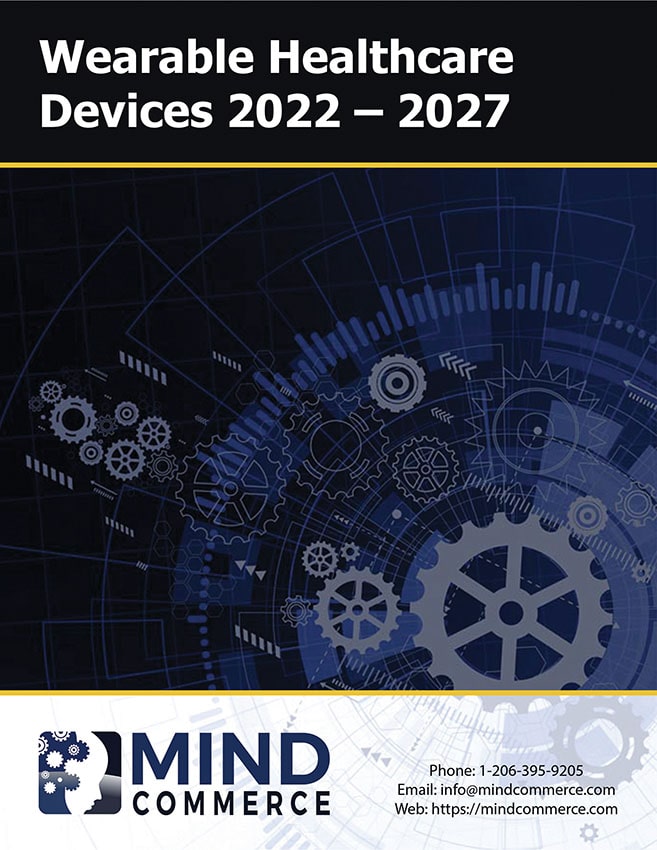Description
The connected wearable healthcare device market addresses medical, wellness and fitness segments. Connected wearable devices are therefore used for many use cases and are many and varied, consisting of various form factors depending on the purpose and placement of the human body. Wearable devices can be worn and/or integrated into apparel to become less intrusive. Sensors (biomechanical, motion, etc.) may be placed at specific parts of the body to communicate with an overall Body Area Network system.
Wearable Healthcare Device Market Dynamics
There is great demand in the healthcare industry for remote monitoring and diagnostics. Driving factors include healthcare cost inflation coupled with a rapidly aging global population within the developed countries. For example, 23 percent of United States residents are projected to be age 65 or older by 2030. Improving supply factors within the connected wearable healthcare device market include improvements in electronics miniaturization and innovation leading to reduced device cost.
R&D in wearable healthcare devices is leading to enhanced functionality, form factor improvements, and frictionless integration with the Internet of Things (IoT) systems and solutions. Machine-to-Machine (M2M) communication enables wearable healthcare devices to communicate autonomously with monitoring systems for both real-time decision making and data gathering for future analysis. Secure M2M-enabled data transport and IoT system connectivity facilitates the integration of healthcare info with data analytics solutions.
One of the core reasons for connected wearable healthcare devices is to transmit information for medical support from a licensed professional. However, there is also a market for “quantified self” in healthcare, which refers to the incorporation of technology into data acquisition on aspects of a person’s daily life. This enables a “Do it Yourself” (DIY) tool for consumers to self-monitor and self-report important wellness items such as blood pressure. The alternative is to allow medical data to transmit to a trusted entity.
Advanced healthcare data management solutions, supported by artificial intelligence, are capable of processing massive amounts of healthcare information, including unstructured data acquired from many different sources and contexts. One of challenges for the connected wearable healthcare device market is tying these systems into healthcare devices in a manner in which data is leveraged while simultaneously preserving device security and end-user privacy.
Wearable Healthcare Device Market Report
This connected wearable healthcare device market report evaluates the current state of the device market ecosystem including devices and apps within the medical, wellness, and fitness markets. The report addresses key challenges, market players, solutions, and the future of wearables in healthcare and related industries including fitness and well being. The report also provides an outlook for the future of wearable devices in medical, wellness, and fitness with forecasts for the period 2022 – 2027. This includes application analysis and forecasts by physiological activity and the role of wearables in elder care and assisted living.
Table of Contents
1. Executive Summary
2. Introduction
2.1 Wearable Technology Overview
2.2 Wearable Technology Supply and Demand Dynamics
2.3 Wearable Technology Market Opportunities
2.4 Wearable Technology Market Challenges
2.4.1 Security and Privacy Concerns
2.4.2 Function vs. Form Factors Challenges
2.4.3 Power Management Constraints
2.4.4 High R&D = High Price for Initial Products
2.4.5 Usage Restrictions Impede Access
3. Wearable Technology Ecosystem
3.1 Wearable Technology Device and Application
3.1.1 Personal Health and Fitness Management
3.1.1.1 Activity Trackers
3.1.1.2 GPS Monitoring
3.1.1.3 Other Wearable Devices
3.1.2 Personal Health Insurance
3.1.3 Prevention, Diagnosis, and Management of Disease
3.1.4 Healthcare and Medical Devices
3.1.4.1 Respiratory Monitoring
3.1.4.2 Circulatory Monitoring
3.1.4.3 Google Glass in Healthcare
3.1.5 Sports Performance Enhancement
3.1.5.1 Sport Brands
3.1.5.2 Textiles and Footwear
3.1.5.3 Devices for Particular Sports
3.1.5.4 Wearable Chemical Sensors
3.1.5.5 Concussion Detection
3.1.5.6 Objective Refereeing
3.2 Sensors in Wearable Systems
3.2.1 Flexible Sensors and Nano-sensors
3.2.2 Movement Sensors
3.2.3 Respiration Sensors
3.2.4 Piezoelectric Usage in Sensors
3.2.5 Skin Sensors
3.2.6 Thermal Sensors
3.2.7 Heart Rate Monitors
3.3 Wearables and Cloud Environment
3.4 Wearable Technology Adoption Factors
3.4.1 Enterprise Adoption Challenges
3.4.2 Industry Specific Factors
3.5 Wearable Device and Data Access Factors
3.6 Wearable Technology Future
3.6.1 Continued Growth in Fitness and Health
3.6.2 Importance of Aesthetics
3.6.3 Beyond Glasses, Fitness Bands, and Watches
3.6.4 Emergence of Ambient Internet of Things (IoT)
3.6.5 Wearables, Data, and Analytics
3.6.6 Continued Downward Price Pressure
3.6.7 Expanding to Enterprise and Workplace
3.7 Wearable Technology Key Success Factors
3.8 Evolution of the Wearable Tech Ecosystem
4. Company Analysis
4.1 Xiaomi Corporation
4.2 Guangdong BBK Electronics Industry Co. Ltd
4.3 Alphabet Inc.
4.4 Lifesense Group B.V.
4.5 Johnson & Johnson
4.6 Smiths Group plc
4.7 Roche Holding AG
4.8 Apple Inc.
4.9 Koninklijke Philips N.V
4.10 Qualcomm Inc.
4.11 Medtronic PLC
4.12 3L Labs
4.13 4iiii Innovations Inc.
4.14 Adidas America Inc.
4.15 Atlas Wearables Inc.
4.16 Avegant Corp.
4.17 BSX Insight
4.18 Casio America Inc.
4.19 ConnectDevice Holding Ltd.
4.20 DAQRI
4.21 Seiko Epson Corp.
4.22 FitBit Inc.
4.23 ActiveLinxx LLC
4.24 Foxtel
4.25 Free Wavz
4.26 Fujitsu
4.27 Garmin Ltd.
4.28 Glofaster
4.29 GOQii
4.30 Hövding
4.31 Huawei Technologies Co. Ltd.
4.32 iHealth Labs Inc.
4.33 StarVR Corp
4.34 Instabeat
4.35 Intel Corporation
4.36 Jawbone
4.37 Jaybird
4.38 Jumpy
4.39 Leapfrog Enterprises Inc.
4.40 LG Electronics
4.41 LifeBEAM (Vi Inc.)
4.42 Mio Labs
4.43 Misfit
4.44 Monster Inc.
4.45 Motorola
4.46 Nike Inc.
4.47 NTT Docomo Inc.
4.48 Oculus VR LLC
4.49 o-synce
4.50 Actofit Wearables
4.51 Polar Electro
4.52 Qardio Inc.
4.53 Recon Instruments
4.54 Reebok International Limited
4.55 Samsung Electronics Co. Ltd.
4.56 ShotTracker
4.57 Sony Corporation
4.58 Soundbrenner Limited
4.59 Sqord Inc.
4.60 Suunto
4.61 Thalmic Labs Inc.
4.62 Timex.com Inc.
4.63 Vandrico
4.64 Tobii AB
4.65 Vuzix
4.66 Weartrons Labs
4.67 Xensr
4.68 Zepp Inc.
4.69 ZTE Corporation
5. Market Analysis and Forecast 2022 – 2027
5.1 Global Wearable Device Market 2022 – 2027
5.1.1 Global Wearable Device Market
5.1.2 Global Wearable Device Market by Type
5.1.3 Global Wearable Device Market by Application
5.2 Global Wearable Device Market in Healthcare, Sports and Fitness 2022 – 2027
5.2.1 Global Wearable Device Market in Healthcare, Sports and Fitness
5.2.2 Global Wearable Device Market by Healthcare, Sports and Fitness Application
5.3 Regional Wearable Device Market in Healthcare, Sports and Fitness 2022 – 2027
5.3.1 Wearable Device Market in Healthcare, Sports and Fitness by Region
5.3.2 North America Wearable Device Market in Healthcare, Sports and Fitness: Device, Application, and Country
5.3.3 Europe Wearable Device Market in Healthcare, Sports and Fitness: Device, Application, and Country
5.3.4 APAC Wearable Device Market in Healthcare, Sports and Fitness: Device, Application, and Country
5.3.5 MEA Wearable Device Market in Healthcare, Sports and Fitness: Device, Application, and Country
5.3.6 Latin America Wearable Device Market in Healthcare, Sports and Fitness: Device, Application, and Country
5.4 Global Wearable Device Deployment Unit 2022 – 2027
5.4.1 Global Wearable Device Deployment Unit
5.4.2 Global Wearable Device Deployment Unit by Type
5.4.3 Global Wearable Device Deployment Unit by Application
5.5 Global Wearable Device Deployment Unit in Healthcare, Sports and Fitness 2022 – 2027
5.5.1 Global Wearable Device Deployment Unit in Healthcare, Sports and Fitness
5.5.2 Global Wearable Device Deployment Unit by Healthcare, Sports and Fitness Application
5.6 Regional Wearable Device Deployment Unit in Healthcare, Sports and Fitness 2022 – 2027
5.6.1 Wearable Device Deployment Unit in Healthcare, Sports and Fitness by Region
5.6.2 North America Wearable Device Deployment Unit in Healthcare, Sports and Fitness: Device, Application, and Country
5.6.3 Europe Wearable Device Deployment Unit in Healthcare, Sports and Fitness: Device, Application, and Country
5.6.4 APAC Wearable Device Deployment Unit in Healthcare, Sports and Fitness: Device, Application, and Country
5.6.5 MEA Wearable Device Deployment Unit in Healthcare, Sports and Fitness: Device, Application, and Country
5.6.6 Latin America Wearable Device Deployment Unit in Healthcare, Sports and Fitness: Device, Application, and Country
6. Conclusions and Recommendations
6.1 Future of Wearable Devices in Healthcare
6.1.1 Area of Concern: Privacy and Security
6.1.2 Area of Opportunity: Healthcare Data Analysis
6.2 Future Devices
6.2.1 Increased System and Device Integration
6.2.2 Implantable Medical Devices
7. Appendix
7.1 Overall Connected Device Market and Forecasts
7.1.1 Primary Market Drivers
7.1.2 Wearables in the Workplace
7.1.2.1 Workplace Adoption Factors
7.1.2.2 Wearables in Manufacturing
7.1.2.3 Wearables in Healthcare Industry
7.2 Global Connected Medical Device Market Outlook 2022 – 2027
7.2.1 Global Connected Medical Device Market
7.2.2 Global Connected Medical Device Market by Manufacturing Method 2022 – 2027
7.2.3 Global Connected Medical Device Market by Location/Usage 2022 – 2027
7.2.4 Global Connected Medical Device Market by Connectivity Method 2022 – 2027
7.2.5 Global Connected Medical Device Market by Region 2022 – 2027
Tables
Table 1: Global Wearable Device Market by Type 2022 – 2027
Table 2: Global Wearable Device Market by Application 2022 – 2027
Table 3: Global Wearable Device Market in Healthcare, Sports and Fitness 2022 – 2027
Table 4: Global Wearable Device Market by Healthcare, Sports and Fitness Application 2022 – 2027
Table 5: Wearable Device Market in Healthcare, Sports and Fitness by Region 2022 – 2027
Table 6: North America Wearable Device Market in Healthcare, Sports and Fitness 2022 – 2027
Table 7: North America Wearable Device Market by Healthcare, Sports and Fitness Application 2022 – 2027
Table 8: North America Wearable Device Market in Healthcare, Sports and Fitness by Country 2022 – 2027
Table 9: Europe Wearable Device Market in Healthcare, Sports and Fitness 2022 – 2027
Table 10: Europe Wearable Device Market by Healthcare, Sports and Fitness Application 2022 – 2027
Table 11: Europe Wearable Device Market in Healthcare, Sports and Fitness by Country 2022 – 2027
Table 12: APAC Wearable Device Market in Healthcare, Sports and Fitness 2022 – 2027
Table 13: APAC Wearable Device Market by Healthcare, Sports and Fitness Application 2022 – 2027
Table 14: APAC Wearable Device Market in Healthcare, Sports and Fitness by Country 2022 – 2027
Table 15: MEA Wearable Device Market in Healthcare, Sports and Fitness 2022 – 2027
Table 16: MEA Wearable Device Market by Healthcare, Sports and Fitness Application 2022 – 2027
Table 17: MEA Wearable Device Market in Healthcare, Sports and Fitness by Country 2022 – 2027
Table 18: Latin America Wearable Device Market in Healthcare, Sports and Fitness 2022 – 2027
Table 19: Latin America Wearable Device Market by Healthcare, Sports and Fitness Application 2022 – 2027
Table 20: Latin America Wearable Device Market in Healthcare, Sports and Fitness by Country 2022 – 2027
Table 21: Global Wearable Device Deployment Unit by Type 2022 – 2027
Table 22: Global Wearable Device Deployment Unit by Application 2022 – 2027
Table 23: Global Wearable Device Deployment Unit in Healthcare, Sports and Fitness 2022 – 2027
Table 24: Global Wearable Device Deployment Unit by Healthcare, Sports and Fitness Application 2022 – 2027
Table 25: Wearable Device Deployment Unit in Healthcare, Sports and Fitness by Region 2022 – 2027
Table 26: North America Wearable Device Deployment Unit in Healthcare, Sports and Fitness 2022 – 2027
Table 27: North America Wearable Device Deployment Unit by Healthcare, Sports and Fitness Application 2022 – 2027
Table 28: North America Wearable Device Deployment Unit in Healthcare, Sports and Fitness by Country 2022 – 2027
Table 29: Europe Wearable Device Deployment Unit in Healthcare, Sports and Fitness 2022 – 2027
Table 30: Europe Wearable Device Deployment Unit by Healthcare, Sports and Fitness Application 2022 – 2027
Table 31: Europe Wearable Device Deployment Unit in Healthcare, Sports and Fitness by Country 2022 – 2027
Table 32: APAC Wearable Device Deployment Unit in Healthcare, Sports and Fitness 2022 – 2027
Table 33: APAC Wearable Device Deployment Unit by Healthcare, Sports and Fitness Application 2022 – 2027
Table 34: APAC Wearable Device Deployment Unit in Healthcare, Sports and Fitness by Country 2022 – 2027
Table 35: MEA Wearable Device Deployment Unit in Healthcare, Sports and Fitness 2022 – 2027
Table 36: MEA Wearable Device Deployment Unit by Healthcare, Sports and Fitness Application 2022 – 2027
Table 37: MEA Wearable Device Deployment Unit in Healthcare, Sports and Fitness by Country 2022 – 2027
Table 38: Latin America Wearable Device Deployment Unit in Healthcare, Sports and Fitness 2022 – 2027
Table 39: Latin America Wearable Device Deployment Unit by Healthcare, Sports and Fitness Application 2022 – 2027
Table 40: Latin America Wearable Device Deployment Unit in Healthcare, Sports and Fitness by Country 2022 – 2027
Table 41: Global Overall Wearable Unit Sales vs. Revenue
Table 42: Global Connected Medical Device Market by Manufacturing Method 2022 – 2027
Table 43: Global Connected Medical Device Market by Location/Usage 2022 – 2027
Table 44: Global Connected Medical Device Market by Connectivity Method 2022 – 2027
Table 45: Global Connected Medical Device Market by Region 2022 – 2027
License Types
Licensing Rights and Privileges
Our publications represent client privileged information. No material in them may be stored, reproduced, distributed, in whole or in part, without prior written permission from Mind Commerce.
License Types
Single-User: Provides the right to the purchaser or their designee to utilize a publication including reading, printing, and storing on one machine such as a laptop or desktop computer. This license is appropriate for an individual or single-person usage within a company.
Multi-User: Provides the right for a group of up to five people within an organization to utilize a publication including reading, printing, and storing on one machine for each respective user. (Note: Let us know if you need a special license for more than five people but less than an entire corporate site).
Enterprise Site: Provides the right for a Single Site of an Organization to store, read, and distribute a publication within its own organization. This licensing option is often chosen by businesses or NGO’s that have a single site/location.
Global Enterprise: Provides the right for an Entire Global Organization to store, read, and distribute a publication within its own organization (including placement on corporate intranet), but not distribute outside the enterprise to any third party. This licensing option is often chosen by large businesses, governments, or NGO’s to Benefit all Employees and also to Maintain Organizational Intellectual Property Compliance.
Payment Options
Mind Commerce offers flexible and convenient methods for ordering research and paying for purchases:
- Credit Card: Major credit cards via secure online, fax, or over the phone – Read More
- Purchase Order: We accept corporate PO to initiate a research order – Read More
- Prepayment: Purchase prepaid credit for future research requests – Read More
- Payment via Check, ACH, or Wire: Electronica of physical check – Read More
- Alternative Payments: Payment via a client’s PayPal account – Read More





